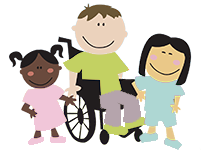Signs of Delayed Speech & Language Development
[vc_row][vc_column][vc_column_text]Children develop at different rates, but there are some guidelines for knowing if your child is generally on track in his or her development. Knowing what is and is not typical for a child’s speech and language development can help parents know if their child is on track or if there is a cause for concern.
Types of Speech & Language Developmental Delay
 A developmental delay in language refers to a child who can speak but does not produce as many words as would be expected for his or her age or intellectual ability level. A developmental delay in speech refers to a child who can produce words, but is difficult to understand. A child may have a delay in receptive language, which is the child’s ability to process and understand what is being said. An expressive language delay means that the child has difficulty producing speech. A child can be diagnosed with a receptive delay, an expressive delay, or both. Some children also have what is referred to as a delay in pragmatic language. Pragmatic language is the use of language in a social setting. Although typically associated with children who have a diagnosis of autism spectrum disorder, a child without a diagnosis of autism can also experience a pragmatic language delay.
A developmental delay in language refers to a child who can speak but does not produce as many words as would be expected for his or her age or intellectual ability level. A developmental delay in speech refers to a child who can produce words, but is difficult to understand. A child may have a delay in receptive language, which is the child’s ability to process and understand what is being said. An expressive language delay means that the child has difficulty producing speech. A child can be diagnosed with a receptive delay, an expressive delay, or both. Some children also have what is referred to as a delay in pragmatic language. Pragmatic language is the use of language in a social setting. Although typically associated with children who have a diagnosis of autism spectrum disorder, a child without a diagnosis of autism can also experience a pragmatic language delay.
Warning Signs of Delays
The signs listed here are general guidelines for typical speech and language development. Each child is different, and some children develop faster or slower than others. However, if your child is showing signs of speech-language developmental delays as listed below, it may be time to talk with your pediatrician, a speech-language pathologist or educational advocate.
By the age of 12 months, your child should be using gestures, such as pointing, reaching, and waving. Around the age of 18 months, use of a few words should be preferred by your child over using gestures, though some use of gestures is still appropriate. Also by this age your child should be able to imitate sounds and understand simple spoken requests. By the age of 24 months, there should be quite a bit of speech and language development that has happened. Your child should be able to both use words and phrases spontaneously and imitate others’ speech and actions. Speech should be used in order to meet personal needs and should not limited to only a few frequently repeated sounds or words. About half of the speech produced should be fairly easy to understand by caregivers and not sound unusual (e.g., nasal tone or having a raspy sound). Your 2-year-old should also be able to follow simple instructions. By the age of 3, the child’s speech should be understandable about ¾ of the time. And at the age of 4, your child should be understood by most people, even people who are unfamiliar with your child, most of the time.
Treatment for Delayed Speech & Language Development
If you are concerned about your child’s speech and language development, the first step is to talk with your pediatrician, a speech-language pathologist, or other trusted health care or educational advocate to have your child screened for developmental delay. If this screening indicates that there may be a delay, a speech-language evaluation will likely be scheduled with you and your child in order to fully evaluate your child’s speech and language abilities as compared to what is expected as developmentally appropriate for his or her age.
If your child has been screened or evaluated for a speech-language delay and the results indicated a delay, it is very important to follow through with recommendations given from the professional(s) who evaluated the child. The earlier you can have your child in speech-language therapy, the better the outcome will be. Typically, a child with speech-language delays will receive speech-language therapy from a speech-language pathologist. This outpatient therapy should be targeted to the specific needs of the child and goals that are developed with the family. This treatment may be given in your child’s educational environment as part of an Individualized Education Program (IEP), for which the child must be formally evaluated through the school system, whether or not the child has already had an evaluation elsewhere. Some children require both outpatient therapy with a speech-language pathologist and treatment within the school setting. Usually the treatment for speech-language delays is 1-on-1 with the speech-language pathologist, and then there will be recommendations for practice at home. However, there may be times when group treatment is available, and this can be especially helpful for children with pragmatic language delays. The frequency of the treatment depends on the needs of the child, the goals developed with the speech-language pathologist and family, and sometimes due to insurance coverage considerations.
Children who experience a speech-language delay and get appropriate treatment often catch up to their peers and eventually are no longer diagnosed with a speech or language delay. Early intervention is key, so screening/evaluation and treatment for these delays will help to ensure a brighter future for your child.[/vc_column_text][/vc_column][/vc_row]
